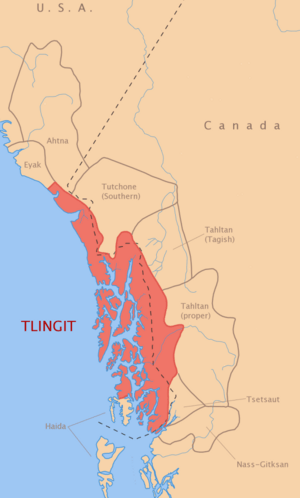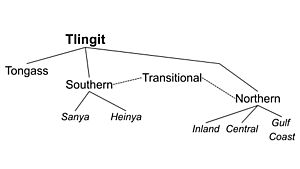Tlingit language facts for kids
Quick facts for kids Tlingit |
||||
|---|---|---|---|---|
| Lingít | ||||
| Native to | United States, Canada | |||
| Region | Alaska, British Columbia, Yukon, Washington | |||
| Ethnicity | 10,000 Tlingit (1995) | |||
| Native speakers | ~170 total (2016–2020) ~50 highly-proficient L1 speakers, 10 highly-proficient L2 speakers (2020, United States) 120 in Canada (2016 census) |
|||
| Language family |
Dene–Yeniseian?
|
|||
| Writing system | Tlingit alphabet (Latin script) | |||
| Official status | ||||
| Official language in | ||||
 |
||||

|
||||
|
||||
The Tlingit language (pronounced KLING-kit, and called Lingít by its speakers) is a special language. It comes from Southeast Alaska and Western Canada. The Tlingit people speak it. This language is part of the Na-Dene language family.
Sadly, Tlingit is an endangered language. This means fewer people speak it today. But many people are working hard to bring it back to life. They want to make sure it is preserved for future generations.
Long ago, Russian missionaries helped create the first written Tlingit. They used the Cyrillic script. Later, when the United States bought Alaska, the use of Tlingit was discouraged. But in the 1900s, efforts began to save and teach the language again. Today, only about 100 elders speak Tlingit as their first language.
Tlingit has some very unique sounds. It also has a complex way of forming words. These features make it different from languages like English or Spanish.
Contents
A Look at Tlingit History
The early history of the Tlingit language is not fully known. People did not write it down until 1786. That's when a person named Robert de Lamanon wrote down some numbers and words. It seems the language spread north over time. It moved from areas like Ketchikan towards Icy Bay.
During the time Russia was in Alaska, the Russian Orthodox church helped create a way to write Tlingit. They also started programs to teach people to read and write it.
But after the United States bought Alaska in 1867, things changed. The government tried to make everyone speak English. This made it hard for Tlingit and other native languages to thrive.
By the mid-1900s, people started working to bring Tlingit back. They created programs to teach and preserve the language. Even with these efforts, the number of people speaking Tlingit continued to go down. Today, many groups are working hard to keep the language alive.
How Tlingit is Related to Other Languages
Tlingit belongs to a group called the Na-Dene languages. This is a family of native languages in North America. For a long time, experts debated if Tlingit truly fit into this family. It shared some sounds and grammar rules. But it didn't have many of the same words as other Na-Dene languages.
Later studies in the 1900s showed strong links between Tlingit and the Eyak and Athabaskan languages. This helped confirm its place in the Na-Dene family.
Some people also wondered if the Haida language was related. Most experts now think Haida is a "language isolate." This means it's not closely related to any other language. But it did borrow some words from Tlingit because they lived close to each other.
An interesting idea is that Na-Dene languages, including Tlingit, might be linked to the Yeniseian languages in Siberia. This idea was first suggested in 1923. In the early 2000s, a linguist named Edward Vajda found evidence for this connection. It would be the first proven link between languages in Asia and the Americas!
Where Tlingit is Spoken Today
Tlingit was traditionally spoken in a large area. This area stretched from the Copper River in Southeast Alaska. It covered many islands in the Alexander Archipelago.
Most of the places where Tlingit is native are in modern Alaska. But some Tlingit speakers live in "Inland Tlingit" areas. These are in northern British Columbia and the Yukon in Canada. You can find them around Atlin Lake (called Áa Tleen meaning "Big Lake") and Teslin Lake. There is also a small group of about 30 speakers in Washington state.
Efforts to Keep Tlingit Alive
The Tlingit language is considered "critically endangered" by UNESCO. This means it is at high risk of disappearing. In 2007, there were about 500 speakers in Alaska and 185 in Canada.
Many people are working hard to save Tlingit. The University of Alaska Southeast offers Tlingit classes. These classes were made free in 2022.
In April 2014, Alaska officially recognized Tlingit as one of its languages. This important step helps support efforts to bring the language back.
Different Ways of Speaking Tlingit (Dialects)
The Tlingit language has about four main dialects. These are different ways of speaking the language. Most of these dialects are similar enough that speakers can understand each other. This suggests the language spread out not too long ago.
- The Northern dialect is spoken in a large area. This includes places like Yakutat, Angoon, and Sitka. It also covers Hoonah and Juneau.
- A part of the Northern dialect is called Inland Tlingit. People speak this in Canada around Atlin Lake and Teslin Lake.
- The Transitional dialect was spoken in places like Kake and Wrangell. It had features that were a mix of Northern and Southern dialects.
- The Southern dialects are spoken from Sumner Strait south to the Alaska-Canada border.
- Tongass Tlingit was a very unique dialect. It was spoken south of Ketchikan. Sadly, its last speakers passed away in the 1990s.
Tlingit dialects also have different ways of using "tone." Tone is how high or low your voice is when you say a word. This can change the word's meaning. For example, Northern Tlingit has two main tones. Southern Tlingit has three. Tongass Tlingit was different. It used special vowel sounds instead of tones. This makes Tongass Tlingit very important for understanding the language's history.
The Sounds of Tlingit
Tlingit has a very interesting sound system. It is quite different from languages like English or Spanish. For example, Tlingit has many "ejective" consonants. These are sounds made by pushing air out quickly from your throat.
Tlingit also has several "lateral" sounds. These are sounds made with air flowing over the sides of your tongue. Interestingly, most Tlingit dialects do not have "labial" sounds. These are sounds made with your lips, like 'p' or 'b' in English. You might only hear them in words borrowed from English.
Tlingit Consonants
Tlingit has many unique consonant sounds. Some are like English, but many are not. For example, it has sounds like 'tl' and 'ch' that are made in special ways. Some sounds are made with a puff of air (aspirated). Others are made with a quick pop from the throat (ejective).
Tlingit Vowels
Tlingit has eight main vowel sounds. These vowels can also be long or short. In the Northern dialect, vowels can have a high or low tone. This means the pitch of your voice changes the word's meaning. For example, áa might mean one thing, and aa might mean another.
All Tlingit words start with a consonant sound. They never begin with a vowel. This is another unique feature of the language.
Writing Tlingit Down
For a long time, Tlingit was mostly written by linguists. They used special symbols to show all the sounds. The Russian Orthodox Church also used a Cyrillic script (like Russian letters) to write Tlingit.
It was hard because many different ways of writing Tlingit existed. This meant you had to learn each system to read old texts. Also, some early writings had mistakes. They often confused short vowels or ejective consonants. Today, there are more consistent ways to write Tlingit.
How Tlingit Sentences Work (Grammar Basics)
Tlingit grammar is very complex. It is known as a "synthetic" language. This means it often adds many parts to words to create meaning. It's like building a word with many small blocks.
Word Order in Tlingit
In Tlingit, sentences usually follow a Subject-Object-Verb (SOV) order. This means the person or thing doing the action comes first. Then comes the thing the action is done to. Finally, the action word (verb) comes last. For example, "The boy the ball threw."
Tlingit Nouns
Nouns are words for people, places, or things. In Tlingit, many nouns are actually made from verbs. This is different from English.
Tlingit Pronouns
Tlingit has a special system for pronouns. Pronouns are words like "I," "you," "he," or "she." In Tlingit, these pronouns change based on how they are used in a sentence. Some pronouns are built right into the verb. Others stand alone.
Directional Words
Tlingit has many specific words to show direction. These words act like nouns. They tell you where something is going or coming from. They can change their form depending on other words added to them.
Small Words (Particles)
Tlingit uses many small words called "particles." These particles add extra meaning to sentences. They can show if you are asking a question. They can also show surprise, doubt, or emphasis. Some particles come before a phrase, and some come after.
Tlingit in Movies and Books
The Tlingit language has appeared in some TV shows. The Irish TV series An Klondike (2015–2017) included Tlingit dialogue. The American show Northern Exposure also featured the language.
In 2023, the Central Council of the Tlingit & Haida Indian Tribes announced a new project. They released the first of nine children's books and animated videos in Tlingit. This project helps teach Tlingit to younger generations. It was a team effort with several groups. The first book, Kuhaantí, was released on October 27, 2023.
See also
 In Spanish: Idioma tlingit para niños
In Spanish: Idioma tlingit para niños


